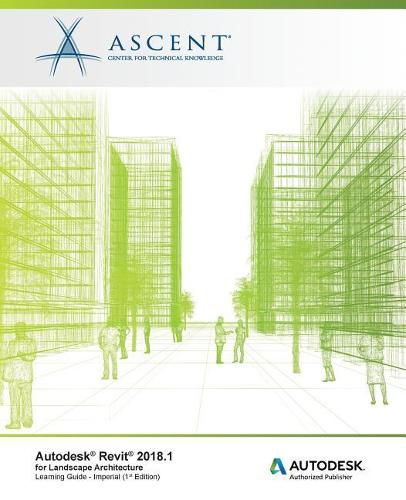Readings Newsletter
Become a Readings Member to make your shopping experience even easier.
Sign in or sign up for free!
You’re not far away from qualifying for FREE standard shipping within Australia
You’ve qualified for FREE standard shipping within Australia
The cart is loading…






The Autodesk® Revit® software is a powerful Building Information Modeling (BIM) program that has allowed countless firms to incorporate the BIM workflow into their designs. As a key component of this workflow, Autodesk Revit allows landscape architecture firms to produce powerfully intelligent designs.
This second edition of the Autodesk® Revit® 2018 for Landscape Architecture learning guide is designed to teach you how to use the Autodesk Revit software, with a focus on creating and documenting full 3D project models for an urban environment, as well as how to use the internal topography tools and the Site Designer add-in extension. You begin by learning about the user interface and basic drawing, editing, and viewing tools. Then you learn how to create topographical surfaces and modify the topography using Autodesk Revit tools and Site Designer tools. From there, you move into modeling hardscapes using walls, floors, and stairs, and adding components such as trees, site furniture and planting areas. Finally, you learn the processes that take the model to the construction documentation phase.
Topics Covered
Understanding the purpose of Building Information Management (BIM) and how it is applied in the Autodesk Revit software. Navigating the Autodesk Revit workspace and interface. Working with the basic drawing and editing tools. Starting a project based on Autodesk Revit models. Creating and modifying basic topography. Using Site Designer tools to modify topography with soft terrain features, sidewalks and curbs. Adding retaining walls, hardscape, stairs and other building elements. Placing components for plantings, furniture, and lighting. Setting up sheets for plotting with text, dimensions, details, tags, and schedules. Creating details.
Prerequisites
An understanding of landscape architecture terminology is an asset.
$9.00 standard shipping within Australia
FREE standard shipping within Australia for orders over $100.00
Express & International shipping calculated at checkout
The Autodesk® Revit® software is a powerful Building Information Modeling (BIM) program that has allowed countless firms to incorporate the BIM workflow into their designs. As a key component of this workflow, Autodesk Revit allows landscape architecture firms to produce powerfully intelligent designs.
This second edition of the Autodesk® Revit® 2018 for Landscape Architecture learning guide is designed to teach you how to use the Autodesk Revit software, with a focus on creating and documenting full 3D project models for an urban environment, as well as how to use the internal topography tools and the Site Designer add-in extension. You begin by learning about the user interface and basic drawing, editing, and viewing tools. Then you learn how to create topographical surfaces and modify the topography using Autodesk Revit tools and Site Designer tools. From there, you move into modeling hardscapes using walls, floors, and stairs, and adding components such as trees, site furniture and planting areas. Finally, you learn the processes that take the model to the construction documentation phase.
Topics Covered
Understanding the purpose of Building Information Management (BIM) and how it is applied in the Autodesk Revit software. Navigating the Autodesk Revit workspace and interface. Working with the basic drawing and editing tools. Starting a project based on Autodesk Revit models. Creating and modifying basic topography. Using Site Designer tools to modify topography with soft terrain features, sidewalks and curbs. Adding retaining walls, hardscape, stairs and other building elements. Placing components for plantings, furniture, and lighting. Setting up sheets for plotting with text, dimensions, details, tags, and schedules. Creating details.
Prerequisites
An understanding of landscape architecture terminology is an asset.